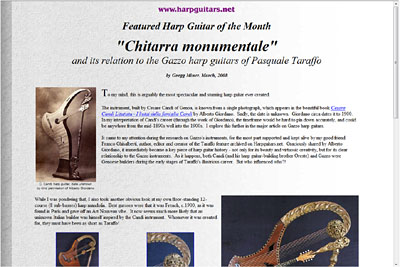
One of the more exciting harp guitar research projects continues to be the floor-standing harp-shaped guitars to come out of Genoa (refer to my 2008 web article, shown above). Among others, Alberto Giordano has been particularly interested and helpful in this investigation. It has repercussions in many areas, including hollow-arm harp guitar “evolution” in Genoa – specifically, how Taraffo’s Gazzo harp guitar may have come about.
The image in my article (top left in above screen shot) comes from Alberto, appearing in his wonderful book, Cesare Candi Litutista – I liutai della famiglia Candi.
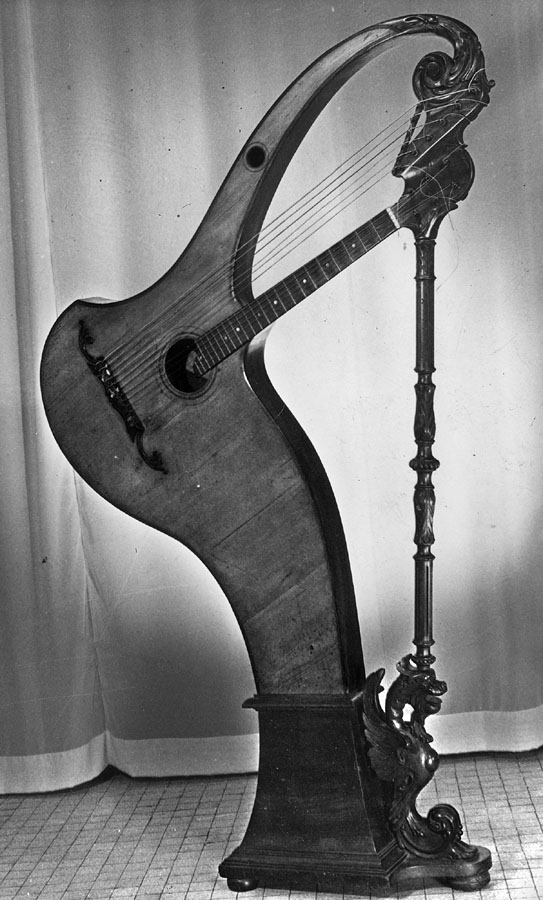
An additional image of a slightly different Candi specimen (note the soundholes) appears in the important book, Romolo Ferrari: e la chitarra in Italia nella prima meta del Novacento (image courtesy of editor Simona Boni). UPDATE January, 2016: We now believe this to be the same instrument, with parts of the top replaced.
Besides this instrument, there are rumors of a similar instrument by a different maker in Milan, an unknown instrument in a private home in Pennsylvania, and of course, my own unlabeled mandolin variant.
Pretty exciting so far, I have to say…
Then, shortly after our trip to Genoa last year, I received this unsolicited treasure out of the blue from the owner, Reidar Edvardsen:
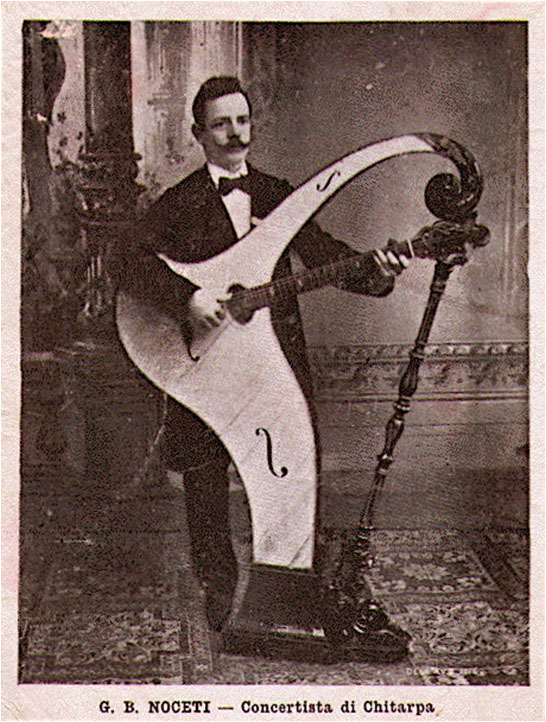
This is a “smoking gun” image (printed on half of an old postcard), found in an Italian fleamarket by Reidar. It answers several important questions, even though it may remain partially shrouded in mystery.
First, let’s address Noceti himself. I had, and have, found few people familiar with him, other than his most famous pupil, Massimo Gasbarroni, who plays pieces by his teacher (and who assures me that, while Noceti had walls full of guitars and other instruments, there was never anything like this in evidence, nor was he ever told about it).
Noceti, alert readers will remember, showed up out of the blue one day on (you guessed it:) Wikipedia, as one of the few historical “harp guitar players” of note (for a more accurate, and still incomplete list, see my own Encyclopedia). The Wiki entry stayed (and remains, for now), as it actually came with a valid reference – a 1903 newspaper clipping.
Of course, I found it aggravating and unwarranted that someone (uncredited, as always) would arbitrarily add a “famous harp guitarist” based on a single news clipping, especially when the “guitharpe” in question is neither seen nor described, other than as “a combination of the guitar and the harp” (which a lot of instrument inventors have similarly claimed).
Nevertheless, I’m not one to look a gift horse in the mouth and dutifully added Noceti to my own encyclopedia (with a disclaimer about his unknown instrument), while beating the bushes for any further information about him.
And then, thanks to Reidar’s rare postcard, we suddenly see his true Chitarpa!
Look familiar? Yes, but look closely. It’s not a harp guitar.
Oh, it’s definitely a spectacular “harp guitar in name only” simply by nature of its incredible and distinctive design (notwithstanding Noceti’s invented name). But it is still only a 6-string guitar, and Noceti only ever wrote for 6 strings.
So his Wiki entry has to go…
Meanwhile, what of the provenance of the instrument?
I immediately shared it with the person most familiar and similarly passionate: Alberto Giordano, who had this to say:
“There is more than a chance that the Candi brothers made it. It is quite peculiar that such a Guitarp does not have any extra strings. The workmanship of the pedestal looks like Cesare’s carving work, while the overall look seems a little earlier than the one pictured in my book. The extensions of the bridge are in the style of Guadagnini of Torino, but less refined; the post connecting the base to the neck looks nearly identical. The fingerboard reminds me more of the work of Oreste, the older brother.”
I had hoped and rather expected this. Further thinking along these lines makes me contemplate the following:
As we can see from the newspaper clipping, Noceti was playing in Paris in March 1903 on an instrument “of his own invention” named the “guitharpe” (chitarpa). I found very little on Noceti but saw that he was in the Italian Guitarists Dictionary (nothing about a chitarpa), and had published some guitar pieces of his own. After finding Massimo through Google, he shared with me this rare document written by Benedetto Di Ponio (another occasional harp guitarist: see my encyclopedia), which he obtained from “Giuliano Balestra, his old colleague at the Conservatory”). In it, Di Ponio states that Noceti obtained a patent for his chitarpa in 1904, and describes the instrument.
For now, I think we can agree that this is almost certainly an instrument by Cesare Candi, or he and his brother. Reider’s postcard clearly labels the instrument as the “Chitarpa” and I would presume that this is the same instrument played in Paris. Thus the date of manufacture would logically be before March 1903, from the N.Y. Times article (the other Candi chitarpas are not dated). In light of the described patent (can anyone track this down?), Noceti may have very well “invented” the instrument, coming up with both the design and the name – though there was almost certainly some collaboration with Candi. We don’t know how much earlier the Noceti Candi was built (prior to March 1903). Regardless, we can say “by 1903” (though perhaps years earlier), and thus “circa date” the other Candi instruments to the same period (“1900’s”). We can also answer some questions posed on my Gazzo page about Taraffo and his own “invention” – as we now know that Noceti/Candi beat Taraffo/Gazzo by a few years to several years. Noceti was presumably in Genoa at the time, as Candi was there (do we know when Noceti settled in Rome?). Could Taraffo have been unaware of it? I think it highly unlikely. I thus imagine the following scenario (just a hypothesis):
- Noceti invents the concept of the harp-shaped, 6-string chitarpa, which he commissions Cesare Candi, or the Candi brothers, to build.
- Cesare Candi builds others, naturally adding sub-bass strings (since he and Oreste were already building simple theorboed harp guitars).
- Young Pasquale Taraffo sees these instruments, and comes up with his own design which increases the basses to 8, and adds a stand, so he can also play standing up, but eliminate the heavy, one-piece construction, and have an easier traveling instrument and stand. He enlists Settimio Gazzo to realize his instrument(s) and plays one to the end of his career.
Interesting that if he knew the specific name of Noceti’s, Taraffo chose not to call his a “chitarpa” or some other fancy new word. Other questions remain: what happened to Noceti and/or his instrument during the early days of Taraffo and his later popularity? What audiences did he play the chitarpa for? Did the two young, and then older, men, ever meet? Fascinating harp guitar history is it not?!
I would be grateful if someone could try to translate the above Di Ponio document and the short Dictionary entry (if legible enough).

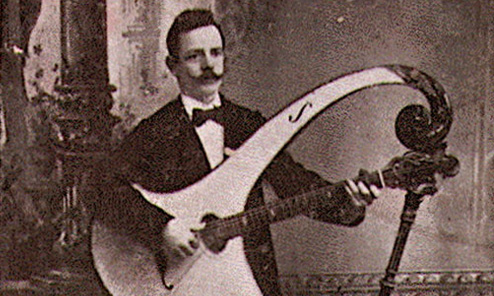
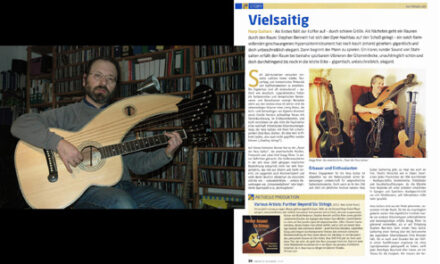
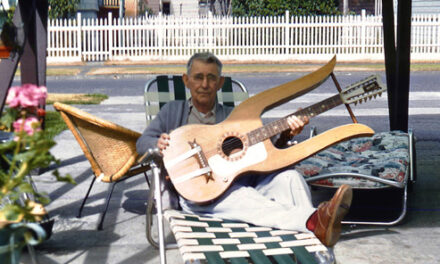
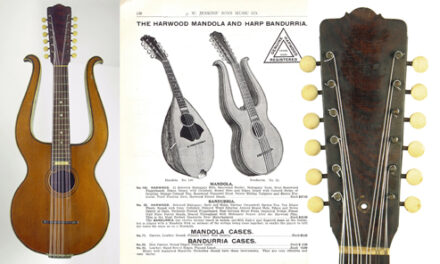
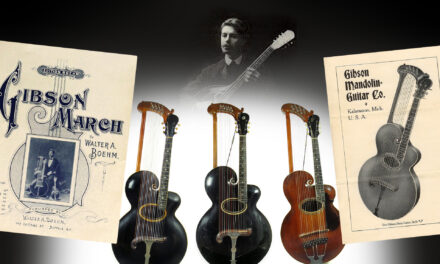
Dear Mr’s Gregg,
I serendipitously came across your site that you were looking for a translation of the G.B. Noceti’s obituary by Benedetto di Ponio.
If you are still there and still need the translation, here it comes.
On August 18th 1957 the famous guitar player Gian Battista Noceti passed away in Rome due to heart failure.
He was born in Genoa on April 9th 1874. He initially studied violin for a few years before switching, still in his youth, to guitar, which supported him financially. So much so that he moved to France where he played the guitar in Paris, Nice and Montecarlo where he was highly regarded for his skills.
He had a jolly disposition and he maintained his keen spirit and humor throughout hard times to the end of his days.
In 1904 he patented a new instrument at the French Ministry of Commerce and Industry. Such musical instrument is reminiscent of both guitar and harp. Its uniqueness resides in the fact that the plane of the strings meets the soundboard at an angle, instead of being parallel to it. Accordingly, the sonority (of this instrument) remarkably increases when the plane of the strings turns perpendicular to the soundboard. He also played in North America, Canada, London and Algeria. Upon returning to Italy he played in several concerts, including the charity concert at Hotel Sturla together with soprano Lucienne Noceti, the concert at Istituto dei Ciechi where the Notturno by Chopin, the Momento Musicale by Schubert and the Sinfonia della Semiramide by Rossini were played, and the concert at the Alfieri Theater in Asti.
In Genoa he founded the Circolo degli Amici della Chitarra and teamed up with violinist Bronislaw Gimple to play the sixth sonatina for violin and guitar by Paganini. He also played at the Paganini Consrvatory.
After settling down in Rome, he played at the Sala Capizzucchi a mixed concert for classical guitar and Hawaiian guitar as a charity for Compagnia di Saint Vincenzo de’ Paoli. Besides some of Nocetis’ own compositions, the program listed the Sonatina in La minor by Paganini, a Preludio in Mi minor by Frescobaldi, two compositions by Tarrega, as well as some Noceti’s transcritions of Beethoven, Gounod and Massenet.
In 1934 he participated in a charity concert organized by the Alto Patronato di S.A.R … (… poor Italian syntax/un-understandable …). He also was a teacher, particularly during his last years when he gathered a large cohort of pupils coming from all walks of life.
To the widow and daughter of the unforgettable G.B. Noceti the A.C.I and the editing team of Arte Chitarristica send their most moved and heartfelt condolences.
Thanks, Marco – yes, I had this, and think I got the gist, but would love a translation!
g
Please Greg,
have a look at this GB Noceti’s obituary published in 1957 by B. DI Ponio:
http://www.justclassicalguitar.com/vpmusicmedia/biblioteca/Noceti.pdf
I will translate it if necessary.
Marco
I love those babies!